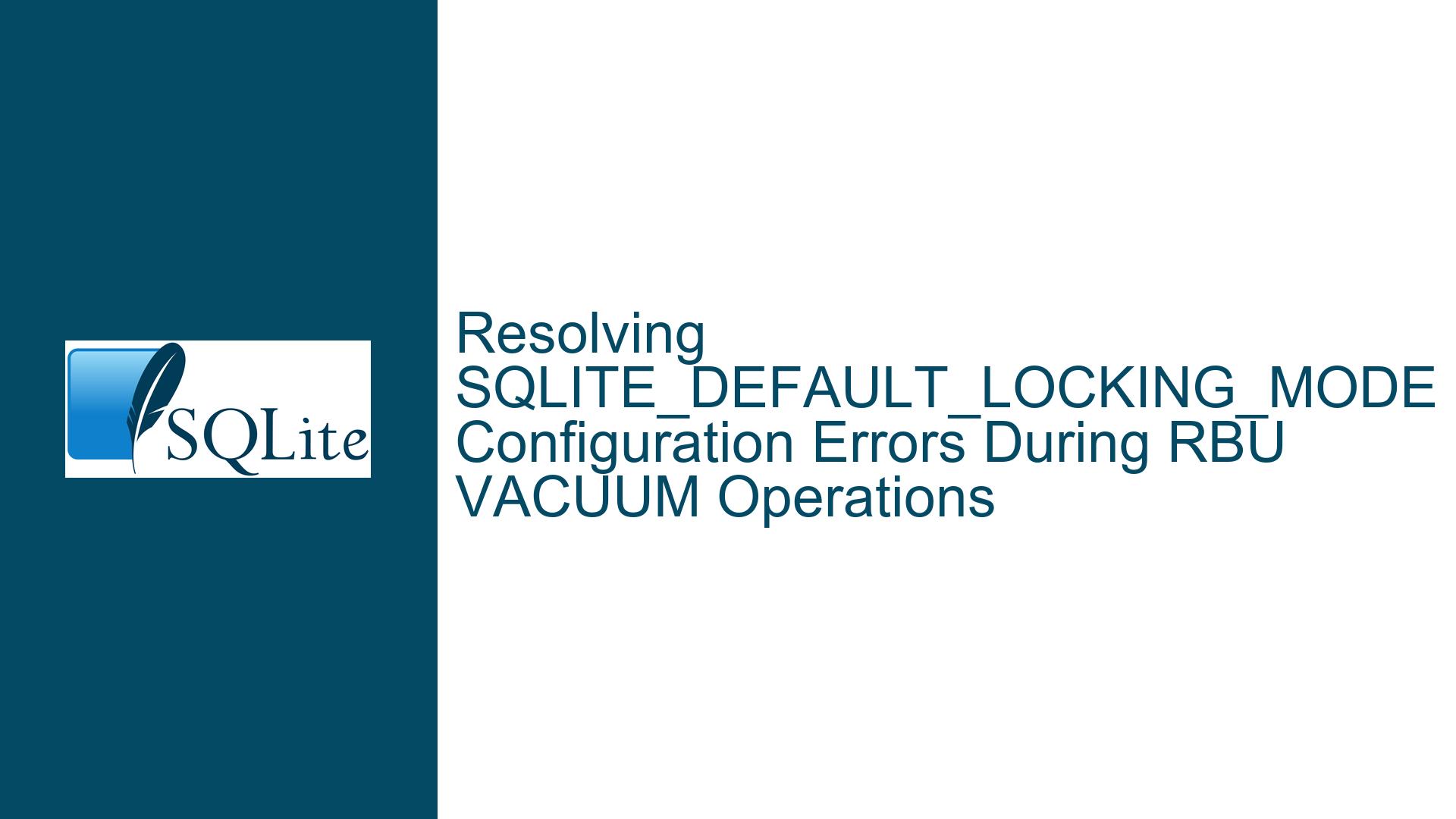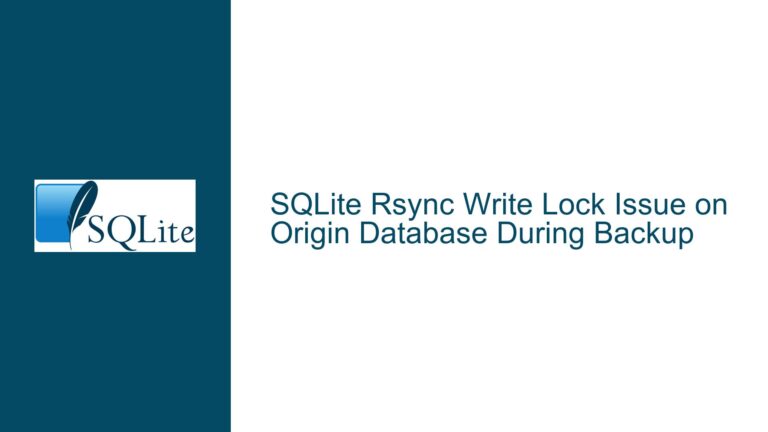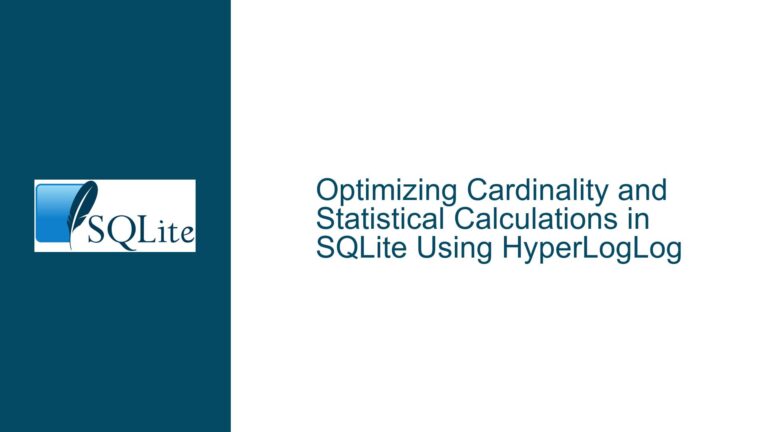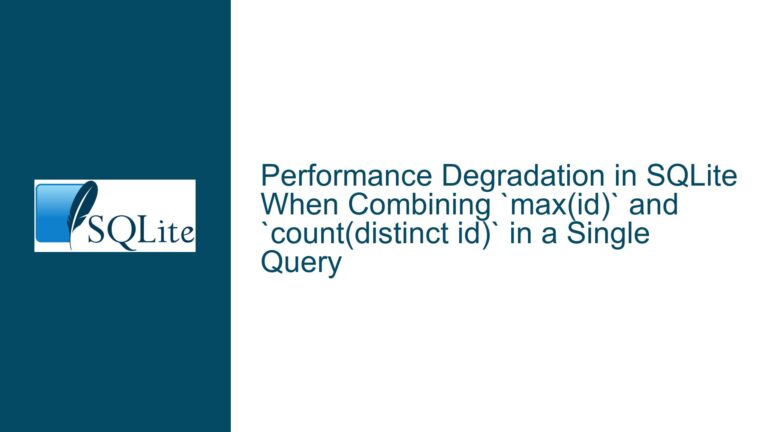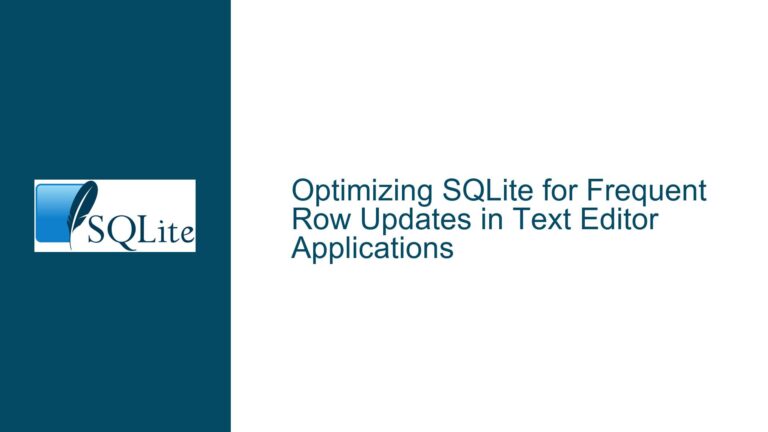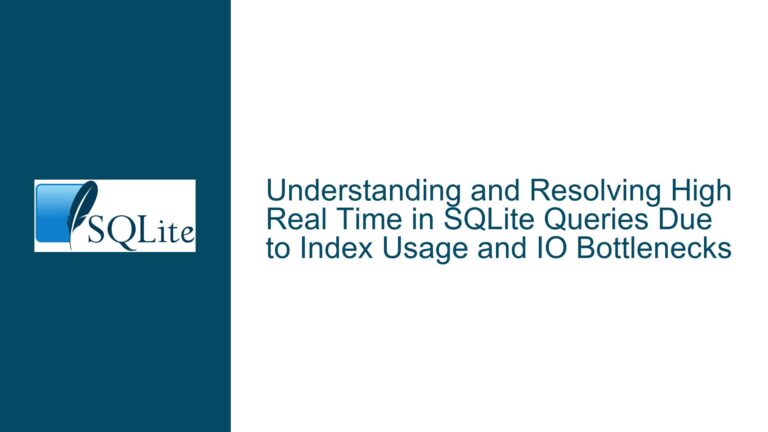Resolving SQLITE_DEFAULT_LOCKING_MODE Configuration Errors During RBU VACUUM Operations
Understanding Locking Mode Conflicts in SQLite During RBU and VACUUM
The core issue revolves around configuring SQLITE_DEFAULT_LOCKING_MODE to enforce exclusive locking by default during database operations such as RBU (Resumable Bulk Update) VACUUM. Users attempting to compile SQLite with SQLITE_DEFAULT_LOCKING_MODE=1 (exclusive mode) encounter operational failures characterized by error codes 5 (SQLITE_BUSY) and 8 (SQLITE_IOERR). These errors indicate conflicts in database access patterns, improper locking mode configuration, or misalignment between compile-time settings and runtime behavior. The problem is exacerbated by the interaction between SQLite’s default locking semantics and operations that require exclusive control over the database file, such as VACUUM or RBU workflows. A comprehensive analysis requires understanding how SQLite’s locking subsystem operates, how compile-time defaults interact with runtime pragmas, and why certain operations demand specific locking configurations.
Root Causes of Locking Mode Misconfiguration and Operational Failures
1. Incorrect Implementation of SQLITE_DEFAULT_LOCKING_MODE at Compile Time
SQLite’s locking behavior is determined at compile time through preprocessor directives such as SQLITE_DEFAULT_LOCKING_MODE. Setting this directive to 1 configures the library to use exclusive locking mode by default for all database connections. However, improper compilation practices—such as failing to rebuild all dependencies after modifying the directive or overriding the setting via conflicting compiler flags—can result in a mismatch between the intended and actual locking mode. For example, if sqlite3.c is regenerated without propagating the -DSQLITE_DEFAULT_LOCKING_MODE=1 flag to all relevant build steps, the resulting binary may retain the default "normal" locking mode. Additionally, some build systems or IDE configurations might ignore or reset custom defines, leading to silent failures.
2. Runtime Overrides via PRAGMA locking_mode
Even when SQLITE_DEFAULT_LOCKING_MODE is correctly set at compile time, the locking mode can be altered at runtime using PRAGMA locking_mode=EXCLUSIVE or PRAGMA locking_mode=NORMAL. If an application or script inadvertently modifies this pragma, it may revert the database to a non-exclusive locking mode, triggering SQLITE_BUSY errors during operations that require exclusive access. Furthermore, the RBU extension and VACUUM command have specific locking requirements: RBU typically operates in a separate database connection, and VACUUM requires exclusive access to rebuild the database file. If the locking mode is not explicitly set or verified before these operations, concurrent access attempts or incomplete locks may cause failures.
3. File System and Process-Level Contention
SQLITE_IOERR (error code 8) often indicates low-level I/O failures, which may stem from file system permissions, anti-virus software interference, or hardware limitations. However, in the context of locking mode configuration, this error can also arise when the operating system or other processes hold conflicting file locks. For instance, if another application or background process opens the database file in a mode incompatible with SQLite’s exclusive lock, the OS may deny access, leading to I/O errors. This is particularly common in multi-process environments or networked file systems where lock coordination is non-trivial.
Diagnosing and Resolving Locking Mode Conflicts in SQLite
Step 1: Validate Compile-Time Configuration
Begin by confirming that SQLITE_DEFAULT_LOCKING_MODE is correctly embedded in the compiled SQLite library. Execute PRAGMA compile_options; in the SQLite command-line interface (CLI) to list all active compile-time options. If SQLITE_DEFAULT_LOCKING_MODE=1 is absent, revisit the build process:
- For manual compilation:
Ensure the-DSQLITE_DEFAULT_LOCKING_MODE=1flag is passed to the compiler when generatingsqlite3.cand linking the final binary. Verify that no subsequent build steps override this define. - For automated builds (e.g., CMake, Makefile):
Inspect build scripts for conflicting flags or environment variables that might resetSQLITE_DEFAULT_LOCKING_MODE.
Example:
# Rebuild SQLite with explicit locking mode configuration
gcc -DSQLITE_DEFAULT_LOCKING_MODE=1 -c sqlite3.c -o sqlite3.o
gcc sqlite3.o my_app.c -o my_app
Step 2: Verify and Enforce Locking Mode at Runtime
Use PRAGMA locking_mode; to check the active locking mode for a database connection. If the result is NORMAL, the compile-time default was either not applied or has been overridden. To enforce exclusive locking:
- Explicitly set the pragma:
ExecutePRAGMA locking_mode=EXCLUSIVE;at the start of the database session. Note that this pragma is a no-op if the connection is already in a transaction. - Isolate RBU and VACUUM operations:
Perform these operations in a dedicated database connection where the locking mode is explicitly set to EXCLUSIVE before initiating the operation.
Example:
-- Start a new connection and set locking mode
.open mydb.db
PRAGMA locking_mode=EXCLUSIVE;
VACUUM;
Step 3: Mitigate Contention and I/O Errors
If SQLITE_BUSY or SQLITE_IOERR persists, investigate external factors:
- Identify conflicting processes:
Use tools likelsof(Linux) orProcess Explorer(Windows) to list processes holding open handles to the database file. Terminate or reconfigure these processes to release locks. - Adjust file system permissions:
Ensure the SQLite process has write access to the database file and its journal files. Disable anti-virus real-time scanning for the database directory. - Retry logic and timeouts:
Implementbusy_timeoutto handle transient locks:PRAGMA busy_timeout=30000;(30 seconds). For applications using the SQLite API, employsqlite3_busy_handler()to customize retry behavior.
Example:
-- Set a busy timeout to mitigate transient locks
PRAGMA busy_timeout=30000;
BEGIN EXCLUSIVE;
-- Perform RBU or VACUUM operations here
COMMIT;
Step 4: Audit RBU and VACUUM Workflows
RBU and VACUUM have unique locking requirements. RBU operates by creating a temporary database to stage changes, which may conflict with the primary database’s locking mode. Similarly, VACUUM requires exclusive access to rebuild the entire database. Review the following:
- RBU-specific considerations:
Ensure the RBU extension is compiled with the same locking mode as the host application. Verify that RBU’s internal connections inherit the correct locking mode. - VACUUM alternatives:
If VACUUM consistently fails, consider usingPRAGMA incremental_vacuum;orauto_vacuummode to reduce fragmentation without requiring exclusive locks.
Example:
-- Enable auto_vacuum to minimize manual VACUUM calls
PRAGMA auto_vacuum=FULL;
Step 5: Debugging I/O Errors
For SQLITE_IOERR, enable SQLite’s error logging using sqlite3_config(SQLITE_CONFIG_LOG, ...) or inspect the extended error code via sqlite3_extended_errcode(). Common resolutions include:
- Disable memory-mapped I/O:
SetPRAGMA mmap_size=0;to bypass memory-mapped file operations. - Test on a local file system:
Copy the database to a local drive to rule out network file system issues. - Check for disk integrity:
Run file system checks (e.g.,chkdsk,fsck) to repair underlying storage errors.
By systematically addressing compile-time configuration, runtime pragmas, environmental contention, and operation-specific requirements, users can resolve locking mode conflicts and ensure reliable execution of RBU and VACUUM operations.
